The Crisis of 1929 , also known as “The Great Depression”, was the biggest crisis of financial capitalism.
The economic collapse began in mid-1929 in the United States and spread throughout the capitalist world.
Its effects lasted for a decade, with social and political ramifications.
Causes of the Crisis of 29

The main causes of the 1929 Crisis are linked to the lack of regulation of the economy and the offer of cheap credits.
Likewise, industrial production followed an accelerated pace, but the population's consumption capacity did not absorb this growth, generating large inventories of products in order to wait for better prices.
Europe, which had recovered from the destruction of World War I, no longer needed American credits and products.
With low interest rates, investors began to put their money on the Stock Exchange and not in the productive sectors.
Realizing the decrease in consumption, the productive sector began to invest and produce less, compensating for its deficits with the dismissal of employees.
A film that takes place at this time is Charlie Chaplin's Modern Times.
New York Stock Exchange Crash
With so much speculation, stocks begin to devalue, which generates the "crash" or "crack" of the New York Stock Exchange, on October 24, 1929. This day would be known as "Black Thursday".
The obvious result was (widespread) unemployment or lower wages. The vicious cycle was completed when, due to lack of income, consumption fell even further, forcing a decrease in prices.
Many banks that lent money failed because they were not repaid, thus reducing the supply of credit. As a result, many entrepreneurs closed their doors, further aggravating unemployment.
The countries most affected by the New York Stock Exchange Crash were the most developed capitalist economies, including the United States, Canada, Germany, France, Italy and the United Kingdom. In some of these countries, the effects of the economic crisis fueled the rise of totalitarian regimes.
In the Soviet Union, where the prevailing economy was socialist, little was affected.
See also:Financial Capitalism1929 crisis in Latin America
The New York Stock Exchange crash had repercussions around the world.
In countries undergoing industrialization, such as those in Latin America, the agro-export economy was the most affected by the reduction in exports of raw materials.
Throughout the 1930s, however, these nations were able to see an increase in their industries, due to the diversification of investments in this sector.
1929 crisis in Brazil
The economic crisis in the United States hit Brazil hard.
At that time, the country exported practically only one product, coffee, and the good harvests had already caused the price of the product to fall.
Furthermore, as it was not a staple product, several importers significantly reduced their purchases.
To get an idea of the scale of the economic problem, a sack of coffee was quoted at 200,000 réis in January 1929. A year later, its price was 21,000 réis.
The 1929 Crisis in Brazil weakened the rural oligarchies that dominated the political scene and paved the way for the arrival of Getúlio Vargas to power in 1930.
See also:Revolution of 1930Historical Context of the 1929 Crisis
After World War I, the world experienced a moment of euphoria, known as the "Roaring Twenties" (also called the Age of Jazz). ).
In the United States, mainly, optimism is palpable and the so-called American Way of Life is consolidated, where consumption is the main factor of happiness.

After World War I, in 1918, industrial parks and agriculture in Europe were destroyed, allowing the US to export on a large scale to the European market.
The United States has also become the main creditor of European countries. This relationship generated commercial interdependence, which changed as the European economy recovered and began to import less.
Added to this, the American Central Bank authorizes banks to lend money at low interest rates. The objective was to encourage consumption even more, but this money ended up on the Stock Exchange.
In this way, in the mid-1920s, investments in stocks on the stock exchange also increased, since these stocks were artificially valued to appear advantageous. However, as it was speculation, the shares had no financial coverage.
To make matters worse, the US government initiates a monetary policy to reduce inflation (increase in prices), when it should fight an economic crisis caused by economic deflation (fall in prices).
First, the US economy, the main international creditor, starts to demand the repatriation of its assets, lent to European economies during the war and reconstruction.
This factor, added to the retraction in US imports (mainly of European products), makes it difficult to pay debts, thus taking the crisis to other continents.
This crisis was already perceptible in 1928 when there was a sudden and generalized fall in the prices of agricultural products on the international market.
See also:CapitalismNew York Stock Exchange Crash

On October 24, 1929, a Thursday, there were more stocks than buyers and the price plummeted. As a result, millions of US investors who put their money on the New York Stock Exchange went bankrupt when the “credit bubble” burst.
This had a knock-on effect, sending the stock exchanges of Tokyo, London and Berlin down in the aftermath. The damage was millionaire and unprecedented in history.
Then, the financial crisis breaks out, as people, in panic, withdrew all their values deposited in banks, which caused their immediate collapse. Thus, from 1929 to 1933, the crisis only worsened.
However, in 1932, Democrat Franklin Delano Roosevelt was elected President of the United States. Immediately, Roosevelt initiates an economic plan called (purposely) "New Deal", that is, the "New Deal", characterized by the intervention of the State in the economy.
As a legacy, the 1929 Crisis left us the lesson of the need for interventionism and state planning of the economy. Likewise, the State's obligation to provide social and economic assistance to those most affected by the degrowth of capitalism.
See also:New DealConsequences of the 1929 Crisis:New Deal
The New Deal economic plan was primarily responsible for the US economic recovery, being adopted as a model by other economies in crisis.
In practice, this government program provided for state intervention in the economy, controlling industrial and agricultural production.
At the same time, federal public works projects were carried out with a focus on the construction of roads, railways, squares, schools, airports, ports, hydroelectric plants, and affordable housing. Thus, millions of jobs were created, fostering the economy through consumption.
Even so, in 1940 the American unemployment rate was 15%. This situation was finally resolved with the Second World War, when the world capitalist economy recovers.
At the end of the war, only 1% of productive Americans were unemployed and the economy was in full swing.
See also:Totalitarian Regimes in Europe